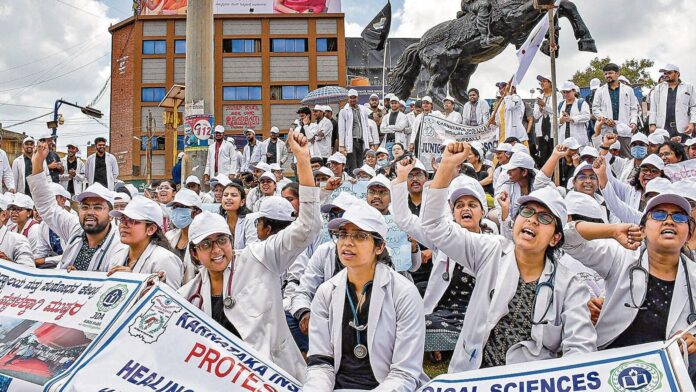In West Bengal, the brutal rape and murder of a trainee doctor in RG Kar Hospital has spawned weeks of daily processions and nightly vigils by thousands of middle- and upper-class residents of Kolkata (and elsewhere) who are unattached to any political party. The future of this story seems more predictable: it will lead to adjustments and modifications, but there will be no fundamental change.
These events are the most recent examples of what is being called ‘the age of leaderless mass movements.’ The political mobilizations of the past were led by political parties or organizations.
They required planning, active and dedicated workers, and direct communication through top-down hierarchical structures with recognized leaders and goals. Think of the Satyagraha salt march led by Mahatma Gandhi or the Sampoorna Kranti movement led by Jayaprakash Narayan in the mid-1970s.
The new movements—if that is the right word for the phenomenon—have no leaders to begin with. They are typically sparked by a significant event that galvanizes into action the accumulated anger against political elites, corruption and injustice.
The organization is done not by existing political parties or their machines, but through social and viral media. When journalists want to know what the movement desires, what the objectives are, they need to ask random protestors on the street or celebrities. There is no movement leader to ask.
The key to this new form of protest is new communication technology. The mobile phone is the contemporary instrument of mass mobilization. It can be used to deploy a flash mob that performs a dance at a railway station or mounts an arson attack on a police station, or to summon thousands to a demonstration or street march.
So potent is its decentralized communication capacity that it is being hailed as the most revolutionary political technology after the printing press which remade religion, language and nation in Europe.
There are numerous examples of these new leaderless mass movements: the Arab Spring of 2011 (and later) that began in Tunisia and spread through Egypt, Libya, Syria, Yemen and other countries and led to the removal of several rulers; the anti-corruption protests that brought down Evo Morales in Bolivia in 2019; and the recent pro-democracy movements in Hong Kong and Myanmar that were crushed.
At a smaller scale, there were the ‘Black Lives Matter’ (sparked by the public murder of George Floyd by police) and ‘Occupy Wall Street’ movements in the US, and the Yellow Jackets protests of 2018 in France.
What lessons can we draw from leaderless movements? Why do some succeed and others fail? What does success mean? And what is the potential of such movements in India?
The Arab Spring provides some guidance. The name was given by Western observers to describe an uprising of youth in several Arab countries. A tinder box of anger against corruption and political suppression already existed. It was set alight by the self-immolation of a Tunisian roadside vendor.
In Cairo, large scale protests, organized largely through social media by politically unaffiliated youth, began in Tahrir Square. After much violence by the military government against street protestors, Egypt’s president Hosni Mubarak resigned—or rather, was ousted by the military. In the Western media, there were many ecstatic proclamations about the power of social media to propel social change.
Egypt’s elections that followed in 2012 were won by the Islamic Brotherhood, a hierarchical old religious organization that had only played a marginal role in the protests. The unorganized, leaderless students who had protested and suffered (and died by the hundreds) were pushed aside.
The new government of Mohamed Morsi lasted barely more than a year and was removed by the Egyptian military in a coup d’état in 2013. General Fattah el-Sisi became and is still president. The Arab Spring in Egypt turned into an Arab Winter.
The power and role of the military was decisive in Egypt. As it was in the ouster of Evo Morales in Bolivia and Sheikh Hasina in Bangladesh. When a military packed with loyalists—as in all three examples—asks you to go, you have no choice.
The masses, the typical balance against armed forces, are no longer with you. Conversely, when the military/police see their self-interest in supporting the regime—as in Hong Kong and Myanmar—protests die and rulers don’t flee. In India, it is impossible to imagine a situation in which the military could compel a prime minister to resign. So, that’s out.
The larger question may be whether it is possible to galvanize all of India on any issue that unites all its fragments, and that too without leadership. At a national level, the answer must be ‘no.’ Indian society’s tapestry of religions, languages, castes, tribes and classes has distinctly varied interests, which have grown further apart in recent decades.
Even Hindu identity is not monolithic. Had it been, there would have existed but one political party. It is possible that some economic catastrophe, such as runaway inflation, may unite a plurality of the population, but mass mobilization will not achieve much except through the ballot box and old-fashioned political parties.
In a democracy, dissent serves the powerful purpose of notifying rulers that they are answerable to the people. But dissent is not an ideology. From the anti-Citizenship Amendment Act movement to the ongoing struggle in West Bengal, dissent is a warning sign to the ruling classes. What it cannot do in India’s fragmented polity is draw citizens from all social identities and classes. It is not a harbinger of revolution.
#age #leaderless #movements #succeed #India
